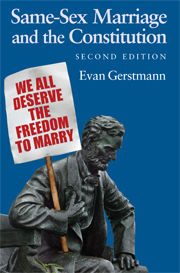Book contents
- Frontmatter
- Contents
- Acknowledgments
- Preface to the Second Edition
- PART I THE CHALLENGE OF SAME-SEX MARRIAGE
- 1 Introduction
- 2 Reason and Prejudice: Is the Heterosexual Monopoly on Marriage Rational?
- 3 Looking for Stricter Scrutiny: Sexism, Heterosexism, and Class-Based Equal Protection
- PART II MARRIAGE AS A FUNDAMENTAL CONSTITUTIONAL RIGHT
- PART III RIGHTS AND EQUALITY
- PART IV RIGHTS IN A DEMOCRATIC SOCIETY
- Bibliography
- Index
2 - Reason and Prejudice: Is the Heterosexual Monopoly on Marriage Rational?
Published online by Cambridge University Press: 05 September 2012
- Frontmatter
- Contents
- Acknowledgments
- Preface to the Second Edition
- PART I THE CHALLENGE OF SAME-SEX MARRIAGE
- 1 Introduction
- 2 Reason and Prejudice: Is the Heterosexual Monopoly on Marriage Rational?
- 3 Looking for Stricter Scrutiny: Sexism, Heterosexism, and Class-Based Equal Protection
- PART II MARRIAGE AS A FUNDAMENTAL CONSTITUTIONAL RIGHT
- PART III RIGHTS AND EQUALITY
- PART IV RIGHTS IN A DEMOCRATIC SOCIETY
- Bibliography
- Index
Summary
For same-sex couples who desire marriage, the Constitution's grand promise of “the equal protection of the laws” has been their greatest hope. Gays and lesbians have gone to court over and over again, pressing their claim that the heterosexual monopoly on marriage violates their right to legal equality. But the promise of equal protection has proved to be complex terrain, especially as applied to the highly emotional issue of same-sex marriage. The public, the litigating attorneys, and especially the courts themselves have struggled to make sense of what legal equality really means for same-sex couples.
To understand this emotionally and intellectually challenging issue, one must begin by understanding how the Supreme Court has traditionally interpreted the equal protection clause of the Constitution. Over the decades, equal protection has come to mean not one standard of constitutional protection, but many standards. Although our intuitive understanding of equal protection might be that the same legal standards must apply to everybody, the reality is quite different; courts apply the equal protection clause differently, depending upon whose rights are allegedly being violated and which rights are at issue. Before we discuss same-sex marriage, we begin with a brief overview of the framework of equal protection jurisprudence.
The Three-Tier Framework of Equal Protection
Under the equal protection clause, the Supreme Court subjects laws to three different levels of scrutiny that vary in their strictness. The stricter the scrutiny the more likely the Court is to strike down the law on equal protection grounds.
- Type
- Chapter
- Information
- Same-Sex Marriage and the Constitution , pp. 14 - 47Publisher: Cambridge University PressPrint publication year: 2008

